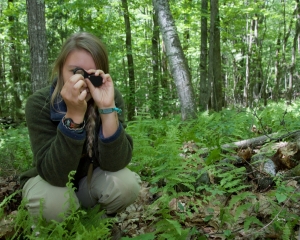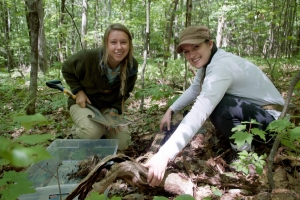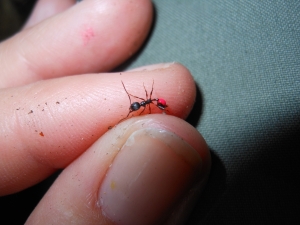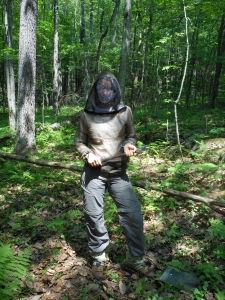You are here
Brutally Honest with Ants: "That’s not your color"
 Integration of the arts into ecology research seems like an idea whose time has finally come. Unfortunately, nature doesn't seem eager to embrace this expressive movement in the form incorporated in my research: the painting of ants. Nevertheless, as part of our summer project, my research partner Cody Raiza and I would find a colony of our ant genus of choice and hunker down for a few hours of tedious ant-butt painting.
Integration of the arts into ecology research seems like an idea whose time has finally come. Unfortunately, nature doesn't seem eager to embrace this expressive movement in the form incorporated in my research: the painting of ants. Nevertheless, as part of our summer project, my research partner Cody Raiza and I would find a colony of our ant genus of choice and hunker down for a few hours of tedious ant-butt painting.
Perhaps I should start by explaining why we painted the ants, or why we even care about ants at all. People don't seem to think much about ants and when we do, we're usually looking to eradicate them – from our picnic baskets, our homes, and our lives. But despite their miniscule size, a world without ants would be a very different one than we know today. Ants have been thanklessly working behind the scenes of our natural world for more than 110 million years (you could say this makes them ANTiques) and now inhabit almost every corner of the globe. Having no native earthworms, ants have been the main aerators and nutrient cyclers responsible for New England's soil, and they are important seed dispersers in New England's forests.
 So you get it now, ants are importANT; but why did we decide to turn them into an art project? It all began with a simple prompt – find out where the ants are going and how far they travel. But how does one go about marking ants in the field? As it turns out, this is a feat yet to be successfully accomplished, and for good reason. It's not only tedious and highly subjective, but when your work is highly dependent on weather and the sheer luck of looking in the right places without completely destroying the habitat, it also becomes frustrating work.
So you get it now, ants are importANT; but why did we decide to turn them into an art project? It all began with a simple prompt – find out where the ants are going and how far they travel. But how does one go about marking ants in the field? As it turns out, this is a feat yet to be successfully accomplished, and for good reason. It's not only tedious and highly subjective, but when your work is highly dependent on weather and the sheer luck of looking in the right places without completely destroying the habitat, it also becomes frustrating work.
 After reviewing the literature, we decided on the well-established marking method of neatly placing a dot of paint on a subject's back; we would designate a color for each colony that would allow us to identify its members. We meticulously painted as many individuals from a colony as possible and then set them free, hopefully to be rediscovered by us later in their new locations.
After reviewing the literature, we decided on the well-established marking method of neatly placing a dot of paint on a subject's back; we would designate a color for each colony that would allow us to identify its members. We meticulously painted as many individuals from a colony as possible and then set them free, hopefully to be rediscovered by us later in their new locations.
Using this color-coordinated method of marking, we narrowed our research to a single genus of ants. In response to any disturbance of their nests, these ants are known to move their colony to a new location. We wanted to figure out how far they move and if there is any specific pattern to their movements. We hoped our findings would not only allow researchers to more effectively conduct field experiments through the ability to reliably track experimental colonies, but would also provide the necessary comparative data to support findings on ant behavior in response to climate change and changing forest dynamics.
Unfortunately, after weeks of trials and tweaking of our procedures, we found that the ants were simply outsmarting us. Searching for our marked colonies, we would often come upon little trails of paint chips that the ants appeared to have removed and discarded. If we were lucky, these trails might lead to our designated colony, now with only a few members still marked; more commonly, we would find one or more nests close by that had no marked ants at all. Whether the marked ants were removing their paint or retreating out of reach of our destructive hands, we cannot be sure.
Though our first experiment did not go quite as planned, it certainly gave us insights into the movement of these colonies, and also allowed us some serious quality time with the ants in which we were able to make many fascinating observations that could lead to new hypotheses to be tested. We've since switched our focus to population density and distribution, which may provide models that can be used to eventually answer our original questions.

Maybe the most important thing I have learned this summer is that scientific research does not usually work out quite the way we might expect. I have been given the amazing opportunity to work in relatively unchartered territory, and with that experience has come the lesson of failure. But while our project failed in meeting the original goal, this by no means makes the work done insignificant. Even when an experiment doesn't work it still contributes to the greater wealth of knowledge, which will in turn surely lead to the success of future studies in that field someday.
The progression of science is not carried by one person, but rather by many individuals, of many disciplines, over many of years, coming together in the greater pursuit of knowledge, and I am excited to have been a part of that collaborative effort.

